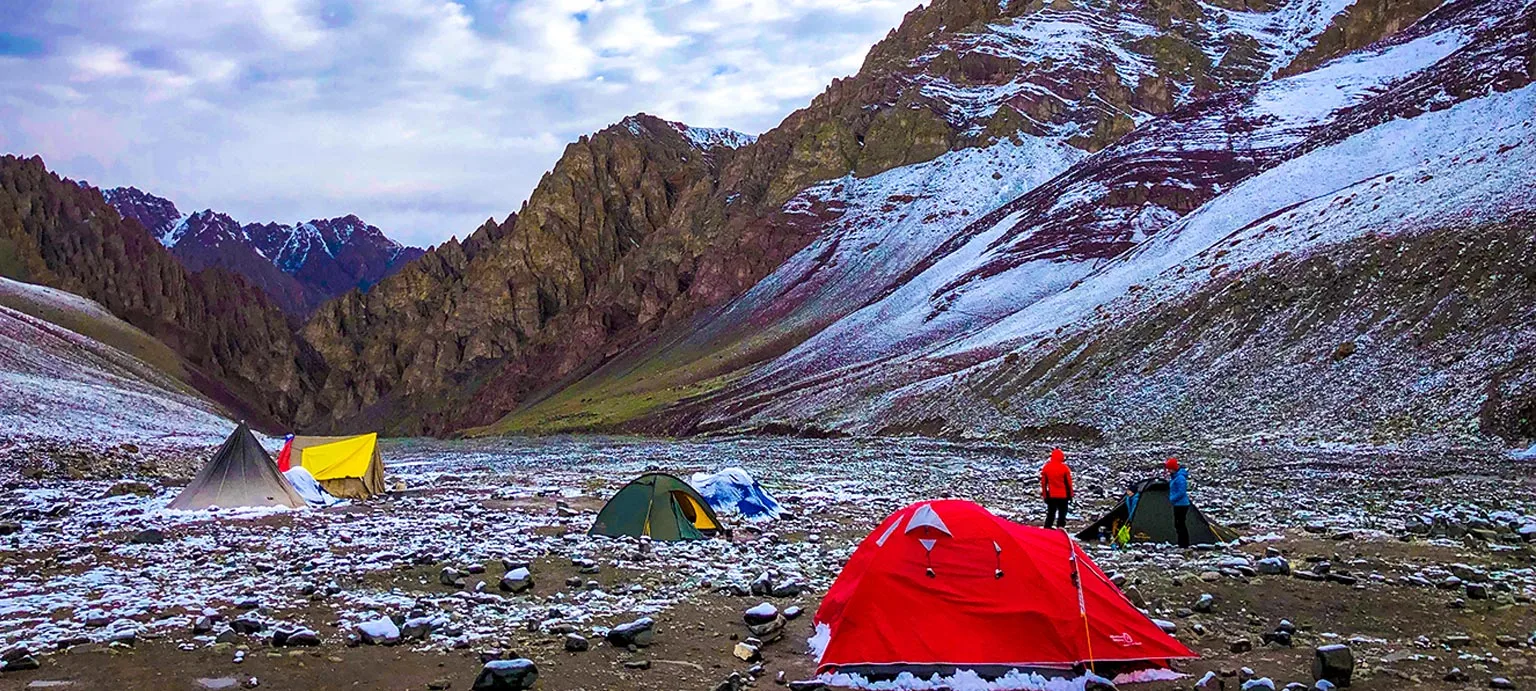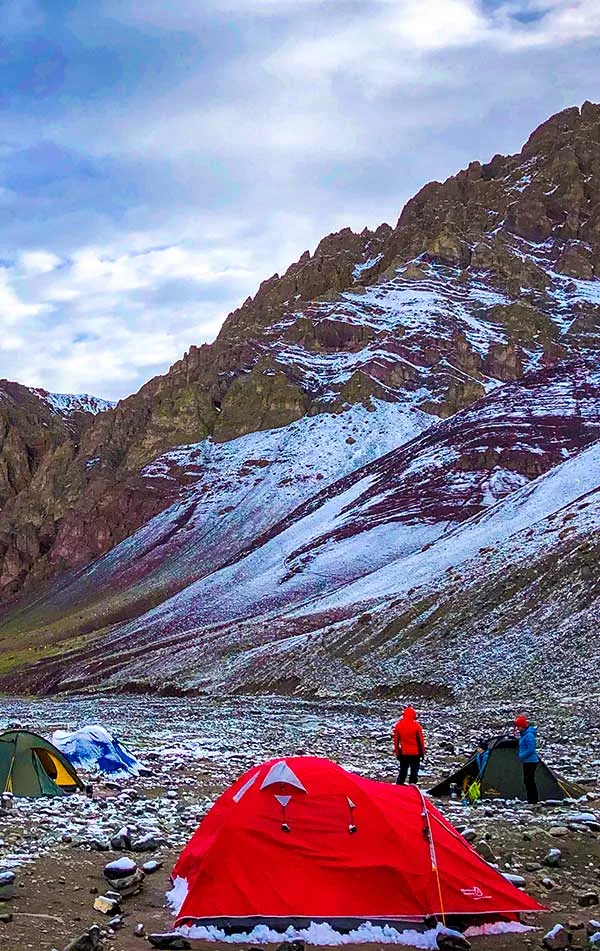
Region
Ladakh | India
Duration
9 Days
Max Altitude
20180 Ft.
Trekking Km
40 KM
Grade
Difficult
Help & Support
+91 8191004846 info@trekthehimalayas.com10:00 hrs to 18:00 hrs | GMT +5:30
Monday - Saturday | Sunday Closed
37000 /Person
- +5% GST (goods and services tax)
- Services Leh to Leh | Included Transport
- Addons
For more information. Please complete this form.
Help & Support
+91 991 772 4737info@trekthehimalayas.com 10:00 hrs to 18:00 hrs | GMT +5:30
Monday - Saturday | Sunday Closed
Overview
Trek Name: Stok Kangri Peak Trek Expedition
Days: 9
Adventure Type: Trekking
Base Camp: Leh
Season:Monsoon | Autumn |
Month:July | August | September | October | November |
Country: India
Altitude: 20180 Ft.
Grade: Difficult
Rail Head: -
Stay: Camping (Twin sharing) & Hotel/Guesthouse
Food: Meals while on trek (Veg + Egg)
Location: Ladakh
Distance: 40 Km.
Trail Type: Circle trail | Camping in various locations, starting and ending at the same point.
AirPort: Leh (Kushok Bakula Rimpochee)
Highlights:
- +5% GST (goods and services tax)
- Services Leh to Leh | Included Transport
One of the most fascinating places on the planet is Stok Kangri that lies in the beautiful area of Ladakh. Ladakh is located in the northern state of India and is famous for compassion and support of its residents. Leh the capital of Ladakh is situated at the height of 3500-3800 mts of sea level and the most adventurous place for the trekking lovers. Trekking in Leh is the best option for trekking in India and hence it attracts tourist from every corner of the world. Stok Kangri is one such peak that has gain tremendous popularity in the last few years. Illustrating the Himalayan range with a wider perspective, this trek embrace deserted surroundings and offer its trekkers the opportunity to experience the complete peace. The entire trail has incorporated many ridges so you can feel the sudden change in scenery. In winter, the whole landscape attains a perfect magnificence. Stok Kangri peak provides you the entire view of Zanskar and the Indus Valley.
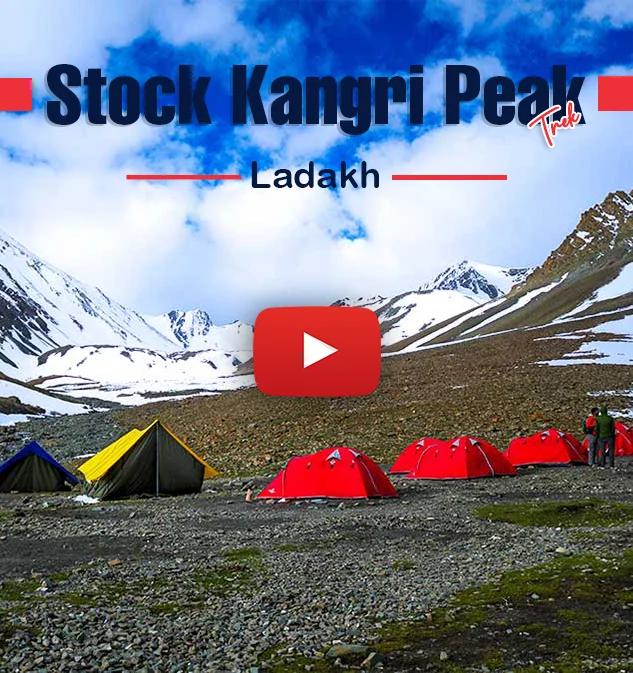
Who Can Participate
-
Age; 15 years.
-
Experience of any high altitude trek, at least 1 treks of 4,000m/13,100ft.
-
The climber must be fit and have sufficient stamina to cover 5 km of distance in 30 minutes without stress.
-
The climber should be able to carry a 12-16 kg backpack.
-
Pulse rate at rest must be in between (60 to 90 beats per minute)
-
Blood Pressure Reading must be in between (DIASTOLIC 70 – 90, SYSTOLIC 100 - 140 mm Hg)
-
Respiratory rate at rest must be in between (12 to 20 breaths per minute)
-
Should not have Liver and kidney issues
-
Should not have Diabetes Mellitus, Bronchial Asthma, Heart problems, Hypertension etc
-
No pacemaker implant
-
People with the Sinus issues, Epilepsy please contact to trek coordinator before booking the trek
-
If your BMI is not normal, Please contact our Trek coordinator before Trek booking.
Medical & Disclaimer Form (Mandatory Documents) Click here to download Medical & Disclaimer Form
- Government Employees can avail the benefit of Special Casual Leave (SCL) when you join us for a trekking expedition. As per the rules of the Pay Commission, Special Casual Leave can be availed for up to 30 days in a calendar year for trekking/mountaineering expeditions through a registered organization. Trek The Himalayas is a registered adventure tour operator by Indian Mountaineering Foundation (IMF) and Ministry Of Tourism (MOT)
- Trekkers have to apply for leave at least 20 days before trek departure date,
- This service is exclusive to Indian government employees and is applicable only for treks within India.
- Do mail at info@trekthehimalayas to apply and mention your booked trek date and trek name.
- Junior trekkers (below 15 years) should have a company of parents/guardians.
- Trekkers between 15 to 18 years can come solo with the disclaimer form signed by parent/guardian.
- Medical & Disclaimer Form (Mandatory Documents) Click here to download Medical & Disclaimer Form
Itinerary
Arrival Leh
Your trekking to Stok Kangri begins with the arrival to Leh. You can easily reach Leh once you come to Delhi. You can reach Leh from Delhi either through a flight or through the road. Taking the flight is a better option as you would be saving a lot of time and energy. Taking the road may cost you a lot of time as you have to first go to either Srinagar or Manali to start for Leh. You can spend a day in Leh to acclimatize to the weather. Trekking in the area of Leh is among the best options among Trekking in India.
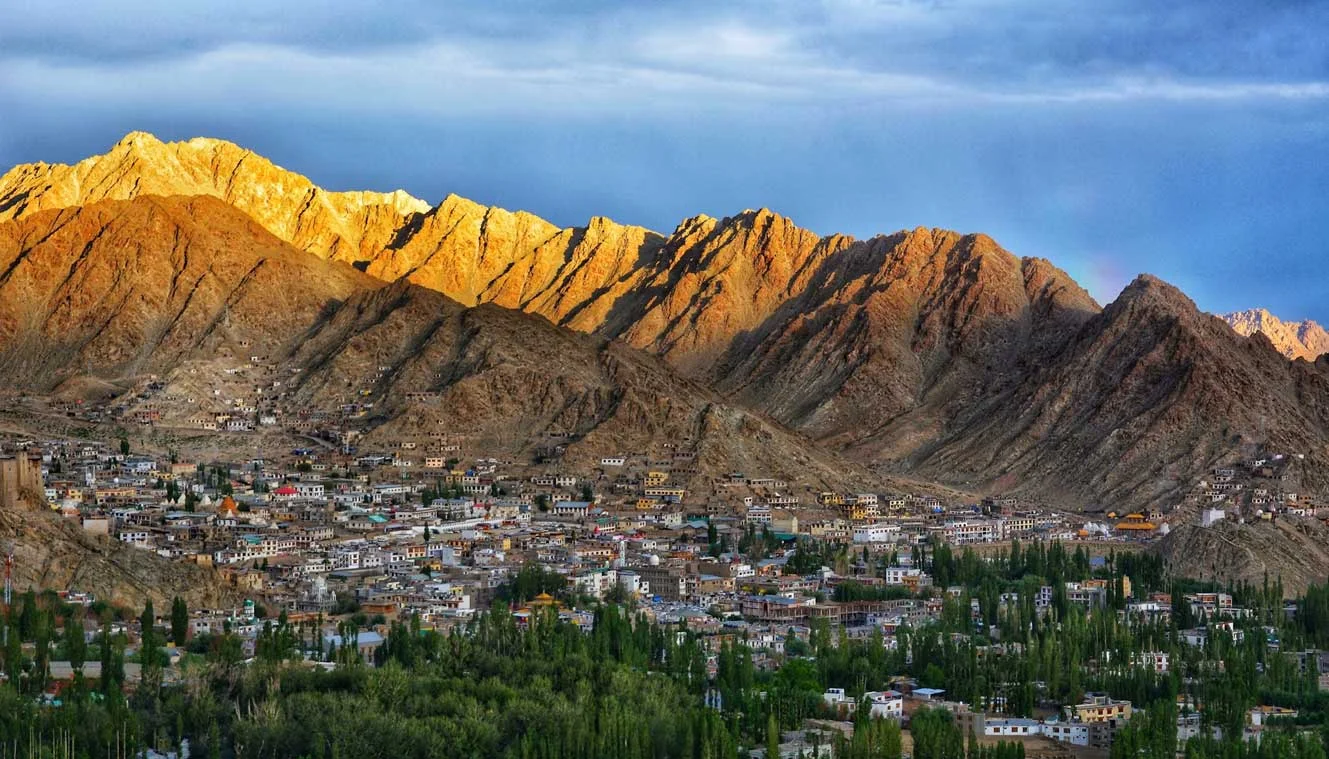
Leh (Acclimatization day)
On day 2nd, you can enjoy the cultural and natural beauty of Leh. This can be considered as a day to get familiar with the town and also acclimatize to the weather. Lah is culturally a rich place. There are dozens of monasteries and ancient temples that you can go around. They are located in and around the town. Therefore you would be getting enough time to go around the place in a day. You can have an overnight stay in Leh. The hotels are easily accessible and rates are reasonable too. You can enjoy trekking here as post monsoon trek and pre monsoon trek.
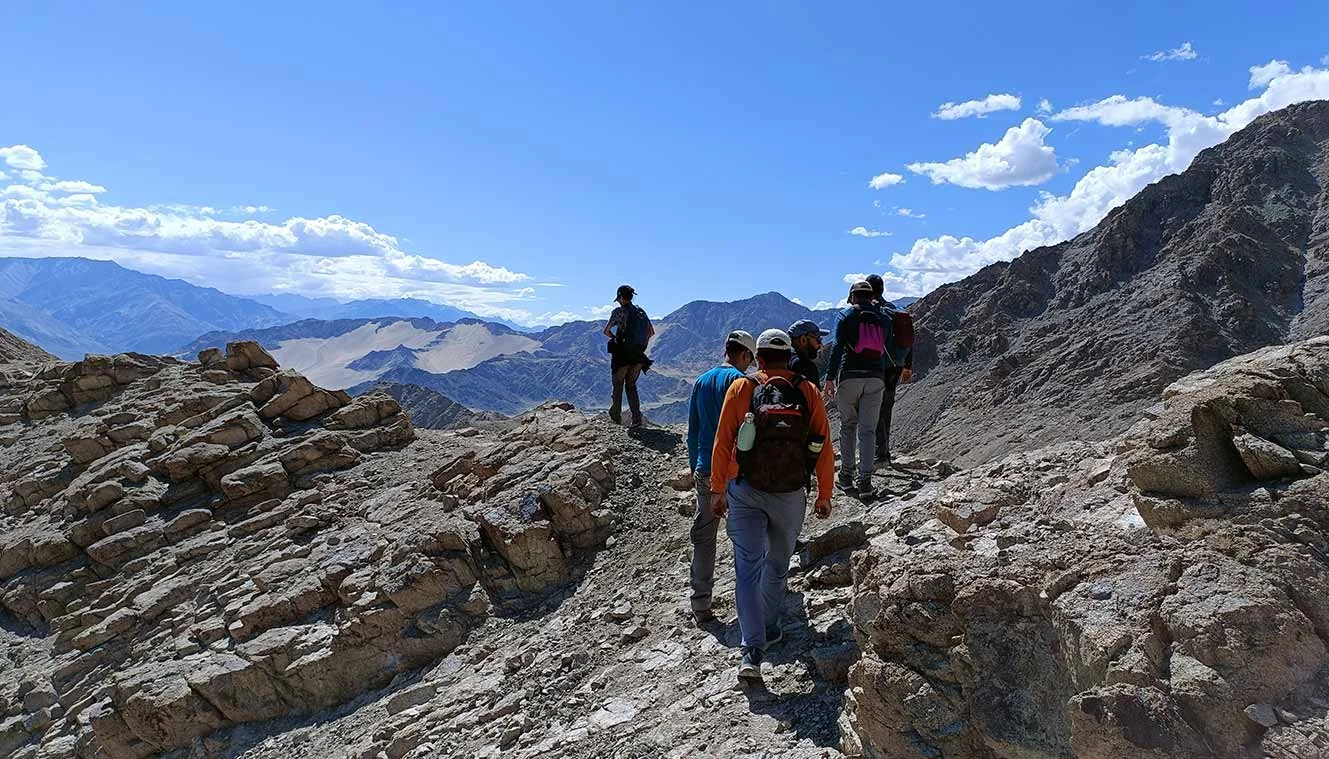
Leh to Chang Ma via Stok Village
It is one of the best sites that you would have once you have decided to trek this area of land. Trekking in Leh, could be considered by some people to be living their dreams. At any point of time, you might just feel that you are right in the middle of heaven. This is a day when you would enjoy a great drive and have an enjoyable trekking experience. The day starts with a drive to Stok village. At the start of the drive from Leh, you would go through many exotic and beautiful scenes. The drive to the Stok village is an adventurous one and is full of natural beauty and lush green trees. The weather is perfectly fine for the summer season. The Stok village lies immediately to the south of Leh and it is well known for a royal palace. The recently crowned king of Ladakh lives here. There is also a small museum inside the palace which has beautiful and religious artifacts.
The day 3 is however the day when you trek to Chang Ma. This might be a difficult trek and you may experience the joy of a snow trek. You would like to spend the night here and the overnight stay would be in tents in the open lands.
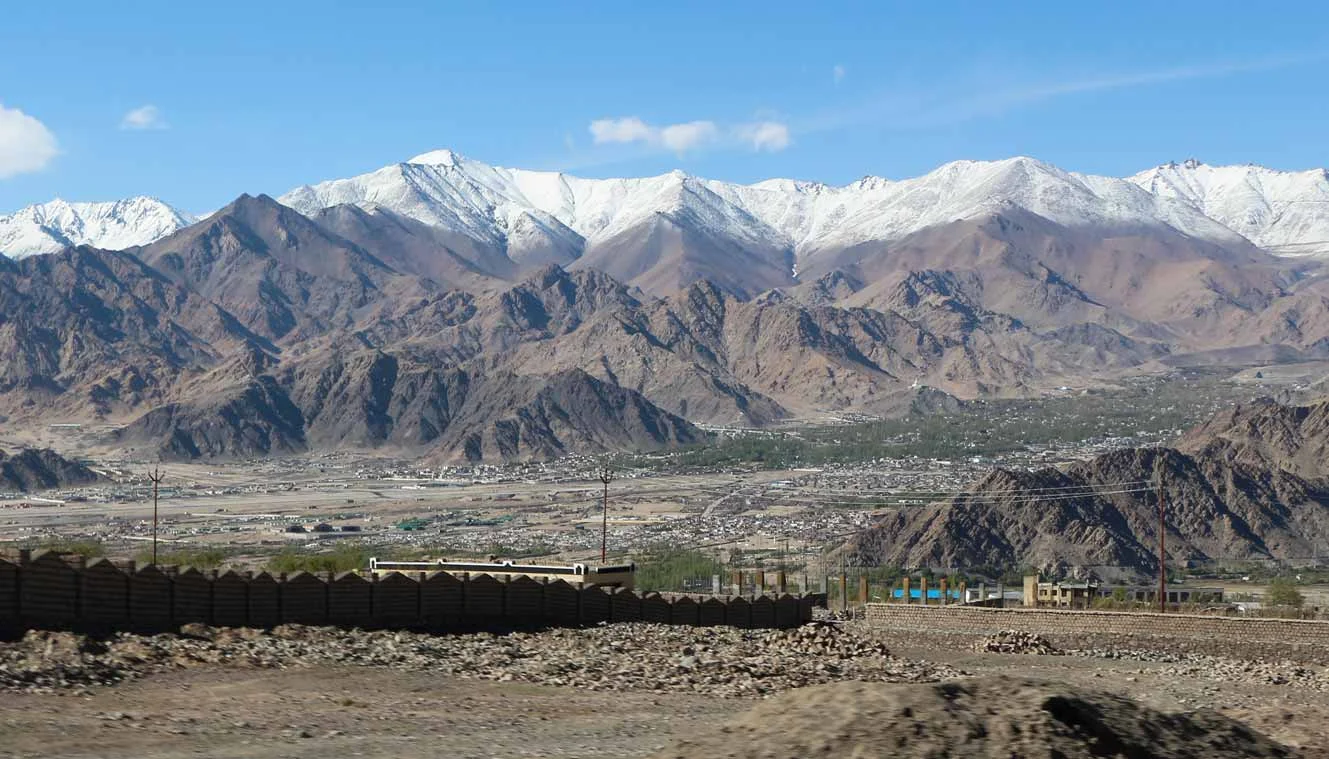
Chang Ma to Mankorma
The whole trek passes through the barren grey landscape of Ladakh. From Chang Ma trek up to Mankorma, this day will show you the real beauty of Ladakh and give you the answer to why Ladakh is known as a cold desert, while trekking you will cross the 2-3 times small streams, it is a fairly easy trek along with the river and you would love the overnight stay in tents.
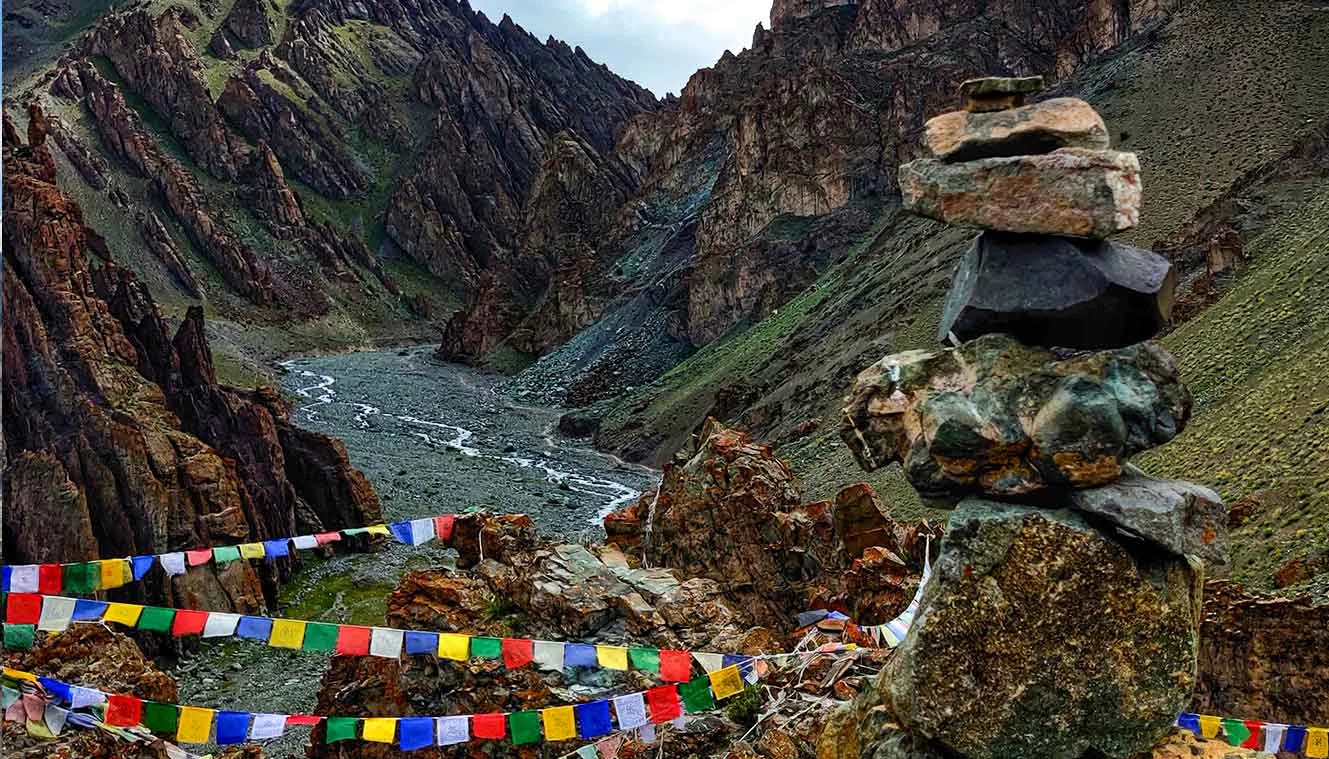
Mankorma to Base camp
A few hours trek takes you back to the base camp. This exotic base camp is a pleasurable place. It lies in a grassy area. This area has a number of water bodies in the form of lakes and water streams. During the day time, you can walk on the upper areas of the campsite and enjoy the views of the surroundings. There are some beautiful peaks like Gulap Kangri, Parcha Kangri and many others. You can also take rest in the base camp to make sure that the group is ready for the next day’s trek and touring. You would get time to acclimatize to the weather. This is pretty necessary because in the coming days, you will find a drastic change in the climate and might experience thin air and a lack of oxygen.
The overnight stay, would again be arranged in tents and make sure that you have enough warm clothes for the lowering temperature.
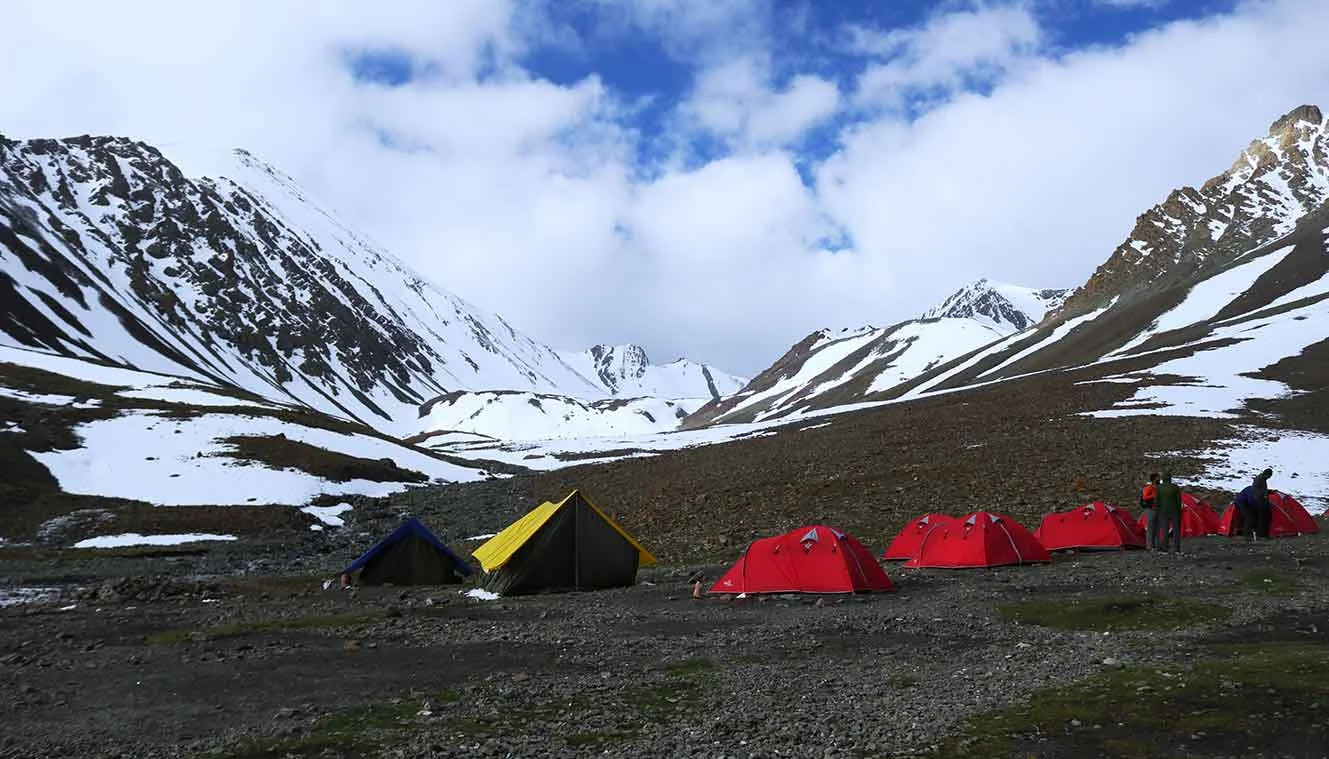
Rest day + training day
This day is an easy day for trekkers. You would enjoy the time for going around and knowing the place to a much better extent. It is essentially a day to train for the upcoming trek and know the possibilities and challenges that are involved in it. Your trek leader and guide would let you know about all the different changes in the terrain. You need adequate knowledge and experience to go around the mountains. There might be situations where you have to trek in the sinking snow. You would find your legs sinking up to your knees. Therefore it is essential that you know the weather and surrounding conditions. It is also a day when you would to take enough rest so that you are well prepared for the coming excursion. The overnight stay would again be in tents. By now, you should be well familiar to the conditions prevailing during the day and night.
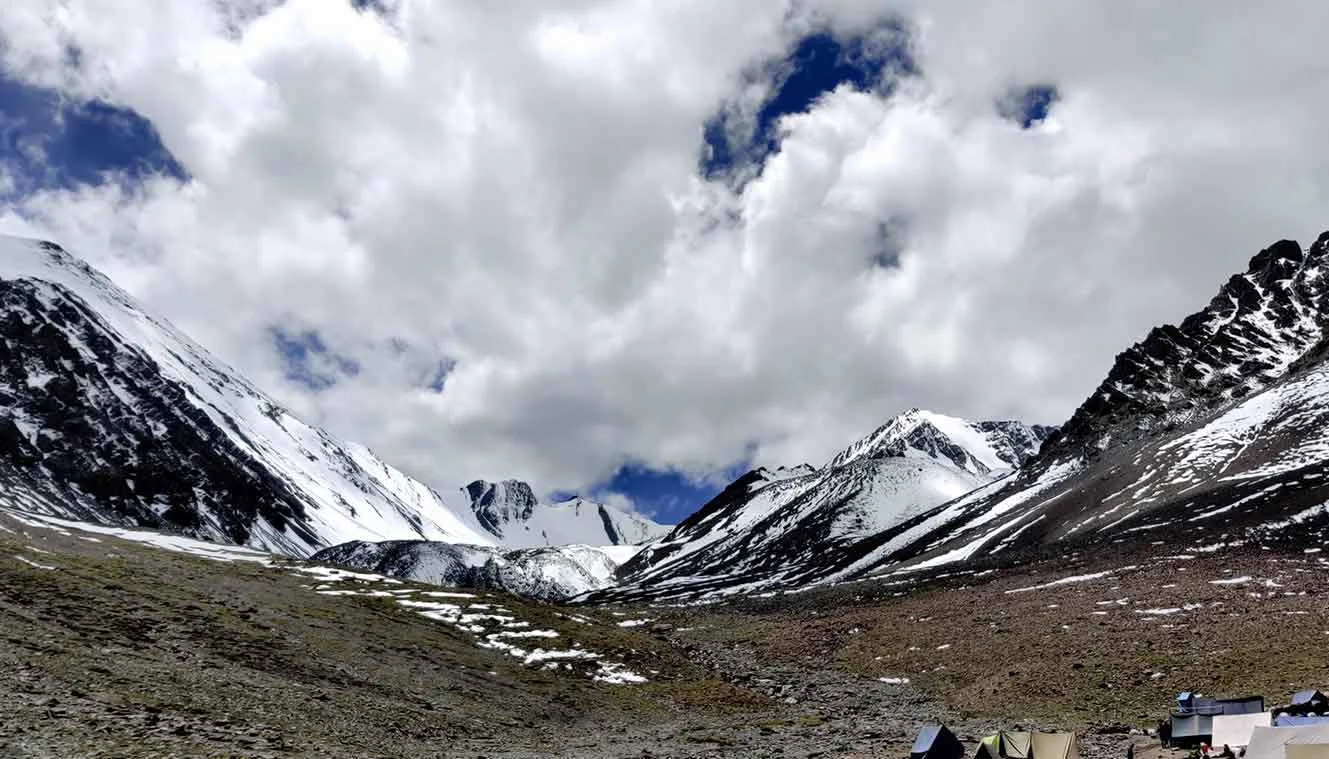
Base camp to Stok Kangri back to Base camp
Now that you have had rest for a day i.e. the Stok Kangri trek, you should be well prepared for the big climb. You should wakeup early to start the climb. The route goes through glaciers and then comes to steep slopes to the summit ridge. This is a long climb, so you should be mentally strong and prepared psychologically. It would take somewhere between 9 to 10 hours for average climbers. Slow climbers may take another 2 to 3 hours in addition. At the start of the trek, after a couple of hours, you should reach to the summit of the ridge. The summit offers you great views of the area. The wide and open surroundings give you a royal feeling. Towards the north, you would get a view of the Karakoram range. The Saser Kangri dominates the sky in the north along with the Karakoram, and the Zansker ranges in the south. The overnight stay, as usual, would be in tents.
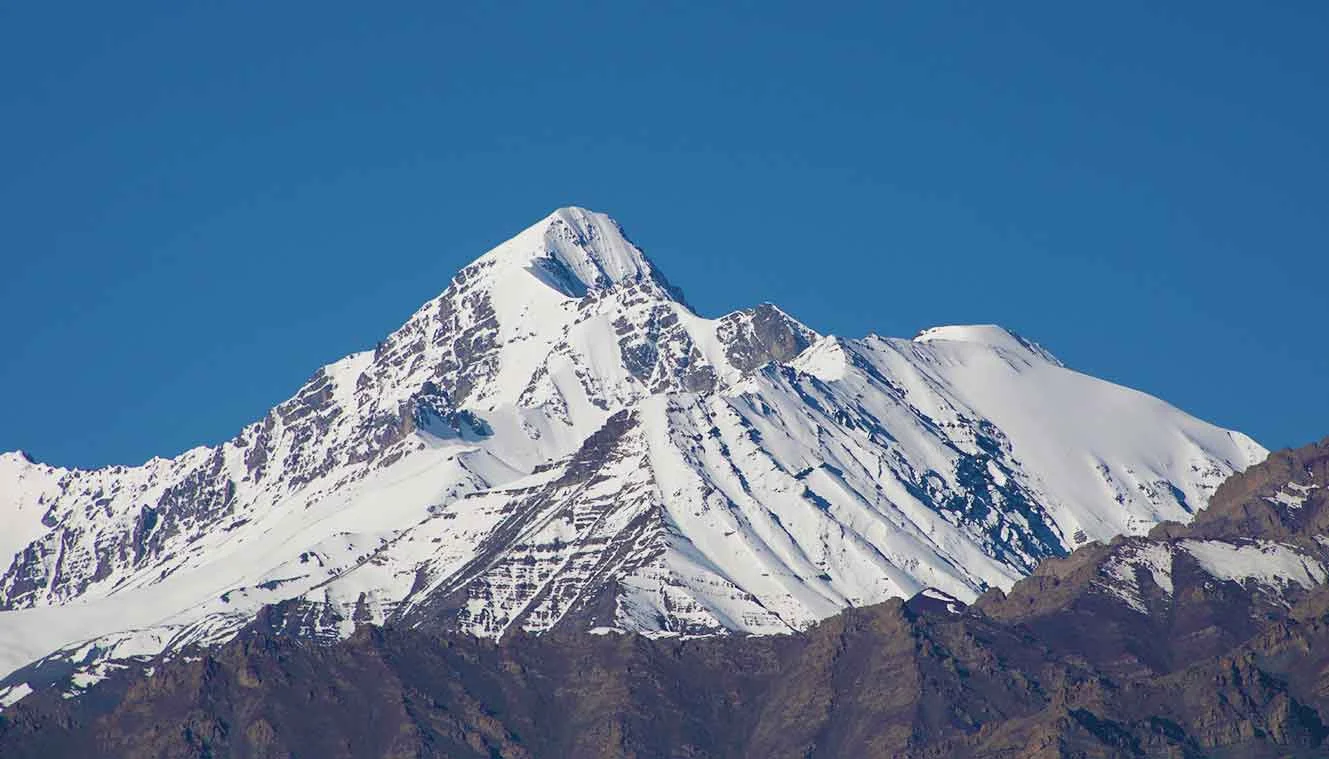
Base camp to Stok Village and drive to Leh
Day 8 would be the ultimate day of your fantastic trekking experience. The trek which included high altitude trekking mountaineering and expedition would finally come to an end after this day. But before you end the day, you will see a lot of snow clad beauty and memorable views of mountain ranges. The joy of Ladakh trekking can be rejuvenated from this spot. As the day rises, you would have to start coming back from Base camp to Leh. The trek back could be difficult and you need to perform care and precision. On the same day, after you reach Leh, you would also have to cover up to Stok Village on your feet. Stok village is the final stopping point for trekking. From Stok village to Leh, you would have to take a drive. The drive may make you nostalgic for all the fun that you had while trekking the mountains in the last eight days.
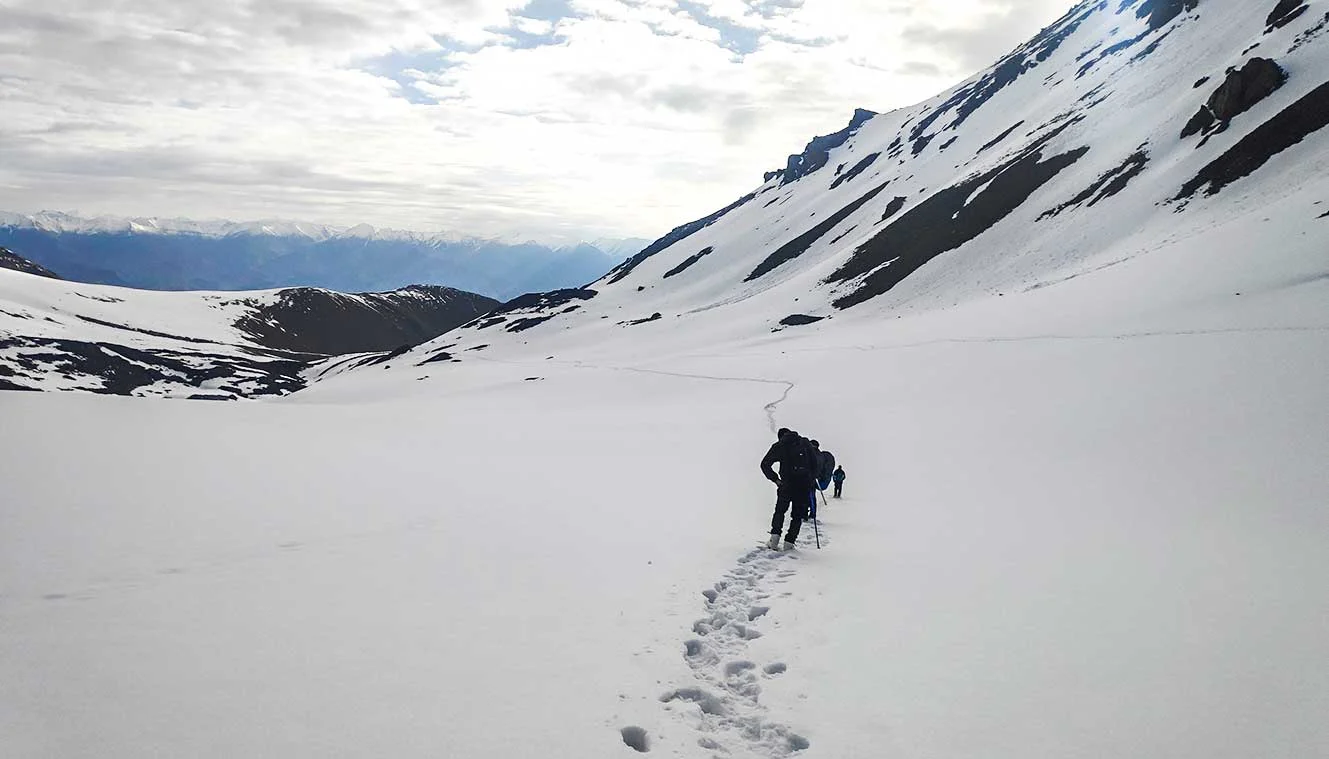
Buffer day
Buffer day is an extra day that is spent at the base camp for a summit attempt in case the whether does not allow. This day is used only when the summit is not possible as per the regular itinerary. Whether to use the buffer day or not is totally team’s decision. Most of the big expeditions have 1-2 days buffer day. Therefore, it is important to consider this day and carefully plan your travel dates too. The costing for buffer day is not included in the trek cost, buffer day cost is Rs 2,600 per day and per person. So, before using the day, make sure you and your team members discuss about it. Fortunately, if everything goes well as per the itinerary, we can plan the day for you. We can make arrangements for other activities like Rafting, Biking, Pangong Lake visit etc.
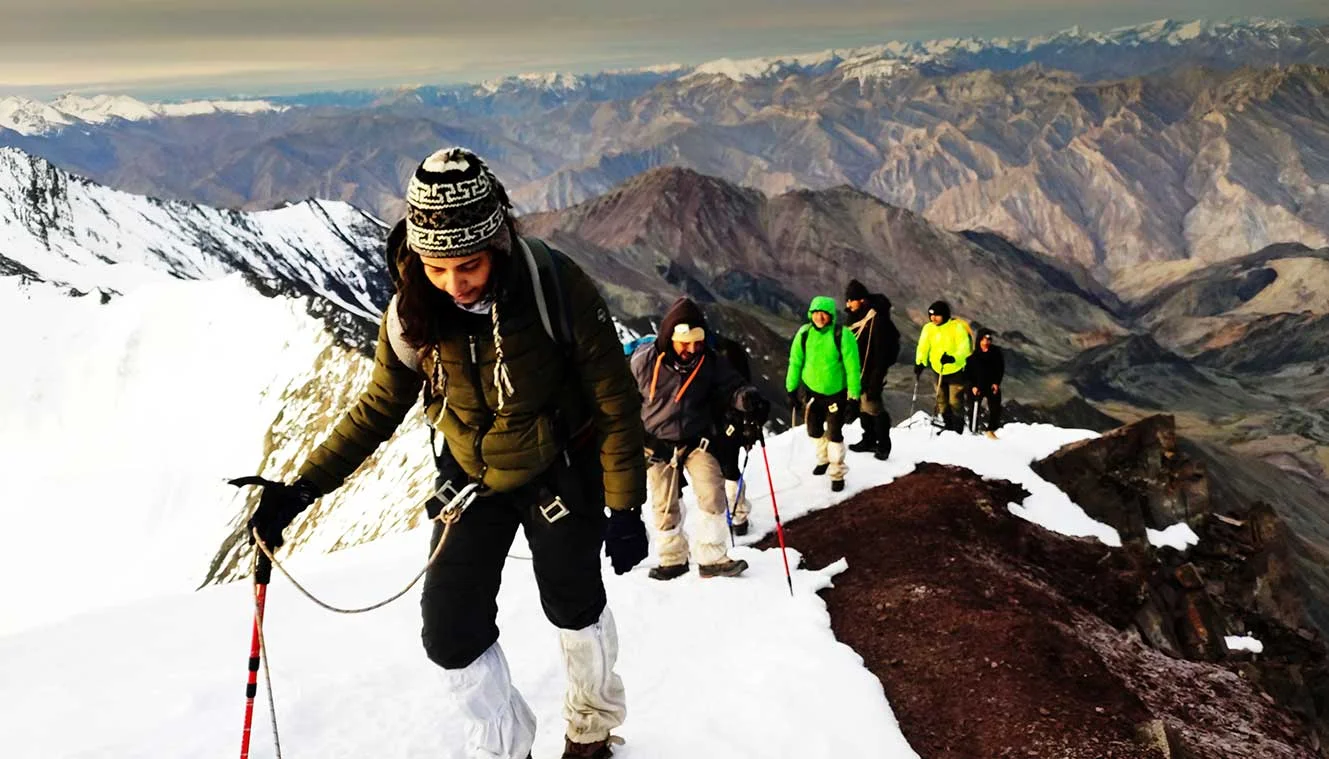
Day-1: Arrival Leh
- Altitude:- 3500 m/11,500 ft.
- Check in Hotel.
- Briefing about the trek at 5 pm (mandatory).
- Bring a copy of ID proof and 2 photo graphs foreigner, a copy of passport and visa.
- Network is available (only post-paid).
- ATM is available.
- Can purchase or rent trekking equipment from Leh.
- Visit of any very high altitude place or pass is not advisable.
- Consumption of alcohol and smoking is strictly prohibited.
- Stay in hotel.
Day-2: Leh (Acclimatization day)
- Acclimatization and sightseeing in Leh.
- Can visit to monasteries: Shey, Thiksey, Sangam, and Hemis.
- Avoid River Rafting, You can plan it after your trek.
- Visit of any very high altitude place or pass is not advisable.
- Stay in hotel.
Day-3: Leh to Chang Ma via Stok Village
- Altitude:- 4,000 m/13,200 ft.
- Stok Village:- 3,500 m/11,500 ft.
- Leh to Stok Village:- Drive 15 km, 35 minutes.
- Trek 6 km, 4-5 hrs.
- Altitude Gain:500m/ 1,700ft.
- Moderate level of ascent.
- Can refill water from river.
- Hot lunch at camp site.
- Night stay in tent.
Day-4: Chang Ma to Mankorma
- Altitude:- 4,400 m/14,400 ft.
- Trek 4 km, 3 hrs.
- Altitude Gain: 400m// 1,200ft.
- Easy level of ascent.
- Can refill water from river.
- Hot lunch at camp site.
- Night stay in tent.
Day-5: Mankorma to Base camp
- Altitude:- 5,000 m/16,350 ft.
- Trek 5 km, 6 hrs.
- Altittude Gain: 600m/1,950ft.
- Moderate to difficult level of ascent.
- Till first half can refill water from river and rest there is no water point.
- Hot lunch at camp site.
- Night stay in tent.
Day-6: Rest day + training day
- TTH team will issue you the technical equipments.
- Learn how to use technical equipments.
- Briefing and planning for the summit.
- Don’t exhaust your body, take rest as much as you can.
- Push for the Summit at 10 pm (Timings may get change).
Day-7: Base camp to Stok Kangri back to Base camp
- Altitude:- 6155 m/20,190 ft
- Trek 7 km each way, 12-14 hrs
- Reach on the Summit by 6 am
- Reach to Base camp by 12 noon
- Packed breakfast and hot lunch at camp site
- Carry enough hot water, only one water point at glacier(very cold)
Route:-
- Base camp to first rest point:- 35-45 min, Steep ascent.
- Rest point to ABC:- 45 min, Gradual ascent.
- To Glacier crossing point:- 40 min, almost flat walk.
- To start of slope:- 20-35 min, moderate to difficult ascent.
- To Shoulder/ South ridge:- 2-2.5 hrs, very difficult ascent.
- To Summit:- 2.5-3.5 hrs, difficult ascent.
Day-8: Base camp to Stok Village and drive to Leh
- Trek 15 km, 6 hrs.
- Drive 15 km, 35 minutes.
- Water available on the way.
- Packed lunch.
- Reach Leh by 5 pm.
- Check in Hotel.
Day-9: Buffer day
- Buffer day will be used if unable to summit due to of any unforeseen circumstances.
- Opting a buffer day will be a team decision not an individual.
- Keep a buffer day in your travel plan.
- Buffer day is not included in the cost.
- Rs 2,600 has to pay, per day and per person.
- Please make any further travel plan on Day 10.
- If buffer day is not used in the Expedition then it can be used to explore Leh.
o Rafting in Zanskar
o Mountain Biking
o Motorcycle Tour
o Khardung La visit
o One day trip to Pangong lake
o full day sightseeing
o Zip line



Important Links
- Mandatory Documents to Bring on A Trek Click Here.
How To Reach
It is essential for everyone to arrive at Leh (01:00 am)
Upon booking the trek, your trek coordinator will furnish you with the hotel details.
Choose any option to reach Leh
-
The easiest and best way to travel is to fly to Kushok Bakula Rimpochi Airport located in Leh. It is just 4 km away from the main city. The airport is well connected to Delhi and also receives flights from Mumbai, Srinagar, Jammu, Chandigarh and other general destinations in India. Even international travellers can fly directly from major cities like Kolkata, Mumbai and Delhi. You can find taxis outside the airport or book a cab to reach the required destination.
-
There are two road routes to Leh
-
Manali (Himachal Pradesh ) to Leh via Baralacha La, Lachulung La and Tanglang La and It covers a distance of 500 km.
-
Srinagar to Leh via Zoji La, Lamayuru Lunar Landscape and Kargil and It covers a distance of 450 km.
-
You cannot reach Leh directly by train as there is no train station in Ladakh. The nearest railway station is Jammu Tawi (700 km from Ladakh) which is well connected with Delhi, Kolkata and Mumbai.
For your return journey from Leh, you have the flexibility to choose between road or air transport options. Please note that our services extend only to the hotel, and the standard hotel check-out time is 11:00 am, if you opt for an air transport then please ensure an early check-out in the morning, as all flights operate during the morning hours
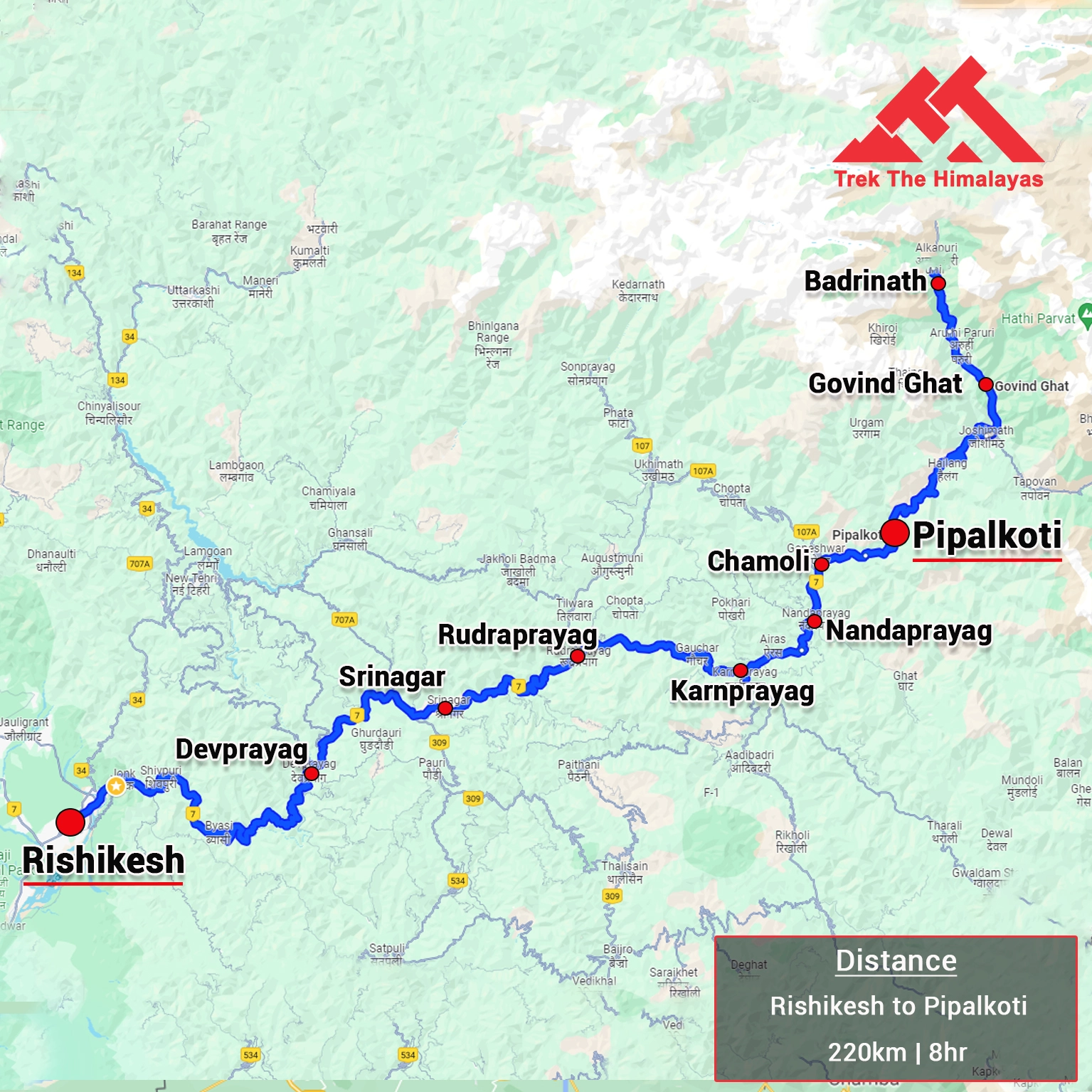
Cost Terms
Inclusion
1. Accommodation (as per the itinerary):
- Guest house in Leh on Day 1, day 2 and day 8 as per the itinerary.
- Camping (Twin sharing basis).
2. Meals (Veg + Egg):
- Meals while on trek (Veg + Egg) as per the itinerary.
3. Support:
- 1 Versatile base camp manager: handles communication and deploys extra manpower in emergencies.
- 1 Mountaineering & First aid qualified professional trek Leader.
- 1 Experienced high altitude chef.
- Local experienced guides (Number of guides depending on the group size).
- Enough support staff.
4. Trek equipment:
- Sleeping bag, Sleeping liners (if required), Mattress, Utensils.
- 3 men all season trekker tent (twin sharing), Kitchen & Dining tent, Toilet tent.
- Camping stool, Walkie talkie.
- Ropes, Helmet, Ice axe, Harness, Gaiters & Crampon (if required).
5. First aid:
- Medical kit, Stretcher, Oxygen cylinder, Blood pressure monitor, Oximeter, Stethoscope.
6. Transportation (as per the itinerary):
- Transport from Leh guest house to Stock village and return as per the itinerary.
7. Mules/porters to carry the central luggage.
8. Clock room facility available at the base camp for additional luggage
9. All necessary permits and entry fees, Upto the amount charged for Indian
10. Services from Leh to Leh.
Exclusion
1. Insurance (Mandatory).
2. Food during the transit..
3. Any kind of personal expenses.
4. Mule or porter to carry personal luggage.
5. Emergency evacuation, hospitalization charge or etc.
6. Anything not specifically mentioned under the head Inclusion.
7. IMF permission fee for Foreigners : Approx. 60-80 USD per person. It might be less or more.
8. IMF permission fee for Indians: Approx. Rs. 3000 per 6 people group. (need to pay in Leh only). It might be less or more.
9. Environment fee : Rs. 600 per person. (as per new Guidelines).
Things can be provided on demand and availability (participant has to pay extra for these things).
1- Satellite phone/set phone - is a type of mobile phone that connects via radio links via satellites orbiting the Earth instead of terrestrial cell sites like cellphones. Therefore, they can operate in most geographic locations on the Earth's surface.
2- Gamow/PAC HAPO Bag (Portable Hyperbaric Bag) - is a unique, portable hyperbaric chamber for the treatment of acute mountain sickness (AMS), also known as altitude sickness.
3- AEDs (Automated External Defibrillators) - are portable life-saving devices designed to treat people experiencing sudden cardiac arrest, a medical condition in which the heart stops beating suddenly and unexpectedly.
Cancellation terms:
Cancellations prior to 25 days from the start of the Trip
Refund options
- 5% deduction of trek fee
- 100% cash voucher for any trip till one year
- Transfer your trek (any trek, any date) to your friend
Cancellation between 24 days and 15 days to the start of the Trip
Refund options
- 30% deduction of trek fee
- 100% cash voucher for same trip till one year
- 85% cash voucher for any trip till one year
- Transfer your trek (same trek, any date) to your friend
Cancellation between 14 days and 10 days to the start of the Trip
Refund options
- 50% deduction of trek fee
- 80% cash voucher for same trip till one year
- 70% cash voucher for any trip till one year
- Book the same trek, in the same season, with any other batch
- Transfer your trek (same trek, any date) to your friend
Cancellation less than 9 days to the start of the trek
Refund options
- No cash refund
- 20% cash voucher for the same trip till one year
- 10% cash voucher for any trip till one year
- Transfer your trek (same trek, same date) to your friend
Note- If a booking is made using a voucher or discount code, the policies related to vouchers and discounts cannot be modified.
In the unlikely event that TTH cancels a trek prior to the scheduled departure date:
While it is extremely rare for TTH to cancel a trek, we understand that unforeseen circumstances or natural disasters may occasionally require us to do so before the scheduled departure. These circumstances could include continuous rain or snow, thunderstorms, snowstorms, landslides, floods, earthquakes, or any other natural calamity that poses a risk to the safety of our trekkers. Additionally, unforeseeable events such as local riots, curfews, pandemics, lockdowns, government orders, or any similar situations that compromise the safety of the trekking experience may also necessitate a cancellation.
In the event of such a cancellation, TTH will provide you with a voucher equivalent to the amount you paid for the trek. This voucher can be redeemed for any of our treks within the next year, allowing you to still enjoy an adventure with us at a later date.
Note
-
The issuance of a voucher is not applicable in situations where you are required to descend from the trek for any reason. The trek leader may make the decision to send you down from the trek due to factors such as insufficient fitness level, symptoms of Acute Mountain Sickness (AMS), high blood pressure, exceeding the designated turn-around-time, health concerns, or if you are found smoking, drinking, or violating the rules set for the trek. In such cases, the provision of a voucher does not apply.
In the rare event that TTH shifts a trek:
We would like to emphasize that weather conditions in high-altitude areas are highly unpredictable and can undergo sudden changes at any time, irrespective of the day. Additionally, circumstances beyond our control, such as natural disasters, political unrest, pandemics, and lockdowns, may impact the feasibility of conducting a trek. In cases where we are unable to proceed with an event due to such circumstances that are beyond our direct control, we will make every effort to provide you with an alternative trek that is safer and more suitable.
In such situations, we will issue a voucher to offset the cost difference between the originally scheduled trek and the alternative trek. This voucher can be redeemed at any time within one year from the date of issue. Please note that a refund fee or reimbursement of the cost difference is not applicable in these cases.
Note:
- Change of trek batch is dependent on the availability of seats in the batch
- In case of transferring a trek to a friend, he/she should satisfy all the mandatory requirements put forward by TTH
- TTH holds the right to change/cancel the policies, without prior notice
- Cash refund is applicable only in case of bookings made without using any promotional offer code or vouchers
Cash Voucher Terms:
- This is a non-transferable voucher
- The voucher cannot be merged with any other offer of Trek The Himalayas
- The voucher is valid for Trek booked directly with Trek The Himalayas in India
- To avail the voucher please use your register phone number or e-mail id
- All the other Terms of booking a trek with Trek The Himalayas are applicable to the voucher
- Trek The Himalayas holds rights to add/remove any of the Terms and Conditions without prior notice
Itineraries are based on information available at the time of planning and are subject to change. "Trek The Himalayas" reserves the right to change expedition dates, people or itineraries as conditions warrant. If a trip must be delayed or the itinerary changed due to bad weather, road conditions, transportation delays, government intervention, airline schedules, sickness, or other contingency for which TTH or its agents cannot make provision, the cost of delays and/or other changes are the responsibility of the participant. TTH reserves the right to decline, or accept, any individual as a trip member for any reason whatsoever.
Trek Essentials
PDF Of Trek Essential Download
| Backpack with rain cover | (50 - 60 ltr) with comfortable shoulder straps |
| Day pack with rain cover | 20 - 30 ltr (If off-load opted) |
| Walking stick | Advisable (At least one) |
| Water Bottle / Hydration pack | 2 bottles of one liter each, People who use hydration pack 1 hydration pack and 1 bottle of one liter, Carry at least one thermos flask. |
| Small size tiffin/lunch box | 1 Nos |
| Snacks | Energy bars, dry fruits, electoral/ors |
| Personal Medical Kit | Consult your doctor |
| T-Shirt (Synthetic quick dry) | 1 Full & 2 Half sleeves |
| Fleece T-shirt | 1 Nos |
| Wind stopper / Fleece jacket | 1 Nos |
| Windproof Jacket | 1 Nos |
| Down feather / Hollow jacket | 1 Nos |
| Thermal inner (Upper and Lower) | 1 Pair |
| Trek Pant (Synthetic quick dry) | 2 Nos |
| Wind stopper / Fleece Pant | 1 Nos |
| Waterproof gloves | 1 Pair |
| Fleece / woollen gloves | 1 Pair |
| Poncho / waterproof Jacket and pant | 1 Nos |
| Sunscreen | 1 Nos |
| Moisturiser | 1 Nos |
| Chap-stick / Lip balm | 1 Nos |
| Toothbrush and toothpaste | 1 Nos |
| Toilet paper & Wipes | 1 Nos |
| Soap / hand sanitizers | 1 Nos |
| Antibacterial powder | 1 Nos |
| Quick dry towel | 1 Nos |
| Head torch | 1 Nos. (Avoid Hand torch) |
| Sun Cap | 1 Nos. |
| Woolen cap | 1 Nos. |
| Balaclava | 1 Nos. |
| Buff / Neck-gaiters | 1 Synthetic & 1 Woollen |
| Sunglasses | UV with dark side cover, People who wear spectacles - (A)- Use contact lenses | (B)- Photo chromatic glasses |
| Trekking shoes | 1 Pair (Waterproof, high ankle, good grip) |
| Floaters / flip-flops | 1 Pair |
| Cotton socks | 7 pairs |
| Woollen socks | 2 pairs |
| Gaiters | 1 Pair (TTH provides when required) |
| Micro spikes | 1 Pair (TTH provides when required) |

Frequently Asked Questions(FAQ)
To register with TTH, visit our website - www.trekthehimalayas.com and create your account. To create your account you will need to use your email address and fill in all the details, set your unique password and your account is ready to use.
- To book a trek with TTH, you first need to register with us and create an account.
- Choose the trek that you want to do and click on available dates.
- You will land at the login page, fill in the required details.
- Add Participants, choose add-on services click on the Pay now button, choose your preferred payment method, and make the payment. TTH accepts multiple payment options, including credit/debit cards, net banking, and UPI.
- You will receive a confirmation email from TTH with all the necessary details about the trek, including the meeting point, transportation, accommodation, and other important instructions.
please send an email to us at info@trekthehimalayas.com or reach out to the numbers provided in the Help and Support section of your Trek Page. We will ensure that your issue is promptly resolved.
To book services such as off-load luggage and transportation, you can find them listed as add-ons. These additional services can be booked at the time of your initial booking. If you miss booking add-ons during the initial reservation, you can log in anytime and easily book 4 days before the departure date add-ons through the platform.
In such a situation, please log in to your account and transfer your trek or date to the desired one within 12 hours or drop us an email at info@trekthehimalayas.com 10 days before the departure date of the trek. After the initial 12-hour period, any changes will be processed according to the cancellation policy.
We recommend visiting our "Suggest Me a Trek" page. By filling out the form, our experts will contact you with the best possible trek options based on your preferences and experience level. Alternatively, you can reach out to us via email at info@trekthehimalayas.com or give us a call using the numbers provided on our website for personalized assistance and recommendations.
Family treks differ from regular treks by focusing on ease of difficulty, offering shorter durations for younger participants, Kid-friendly and easily digestible foods, child-friendly activities, maintaining a higher guide ratio for diverse age groups, and implementing additional safety measures for families.
Family Trek with Kids recommendation Only Dayara Bugyal and Chopta Chandrashila Trek.
Minimum age for TTH treks is typically 7 years, though this may vary depending on the specific trek.
Yes, you can take a kids to a high-altitude trek with a parent. Discuss with a trek expert before booking a trek.
Junior trekkers (below 15 years) should have a company of parents/guardians.
Trekkers between 15 to 18 years can come solo with the disclaimer form signed by parent/guardian.
Medical & Disclaimer Form (Mandatory Documents) Click here to download medical and disclaimer form
Physical Fitness: Ensure your child is physically fit. Engage them in regular exercise, outdoor activities, and hikes to build stamina and endurance. Hydration: Emphasize the importance of staying hydrated at high altitudes. Encourage your child to drink water regularly, even if they don't feel thirsty. Proper Nutrition: Provide a well-balanced diet with sufficient carbohydrates for energy and foods rich in iron to prevent altitude sickness. Adequate Sleep: Ensure your child gets enough sleep in the days leading up to the trek. Quality rest is crucial for altitude adaptation. Educate on Altitude Sickness: Teach your child about the symptoms of altitude sickness, such as headache, nausea, and dizziness. Encourage them to communicate any discomfort immediately. Appropriate Clothing and Gear: Dress your child in layers to adjust to changing temperatures. Ensure they have appropriate trekking gear, including sturdy footwear. Positive Mindset: Foster a positive mindset. Encourage your child, and let them know it's okay to take breaks when needed. Medical Check-Up: Schedule a medical check-up before the trek to ensure your child is fit for high-altitude activities. Consult with a healthcare professional about any potential health concerns.
TTH takes special care to provide wholesome and nutritious food for children on treks. Here are some of the foods that are typically served for children:
Breakfast: For breakfast, TTH serves a variety of options like porridge, cornflakes, bread, butter, jam, honey, boiled eggs, omelettes, and pancakes. Children can choose from these options to fuel themselves for the day's trek.
Lunch: For lunch, TTH serves lunch which includes rotis, vegetables, rice, dal, and salad. The rotis are usually made fresh on the trek and are a good source of carbohydrates. The dal and vegetables provide protein and other essential nutrients.
Snacks: TTH provides healthy snacks like fresh fruits, dry fruits, energy bars, cookies, and biscuits to keep the children energized throughout the day.
Dinner: For dinner, TTH serves a hot and wholesome meal which includes soup, rice, dal, vegetables, and a non-vegetarian dish (if requested in advance). Children can also choose from a variety of desserts like custard, jelly, and fruit salad.
Dietary requirements: If a child has any special dietary requirements, TTH can cater to those needs as well. For example, if a child is lactose intolerant or allergic to nuts, the kitchen staff can make arrangements to accommodate those requirements.
Choosing the right trek for a beginner can be a bit overwhelming as there are many factors to consider such as distance, elevation gain, terrain difficulty, weather, and time of year. Here are some tips that can help you choose the right trek for a beginner:
1. Determine fitness level: Assess the fitness level of the beginner to understand their physical capabilities. This will help you select a trek that is challenging but not too difficult.
2. Choose a well-traveled trail: A well-traveled trail will have more amenities such as signposts, water stations, and shelter. It is also safer as there will be other hikers on the trail.
3. Consider the length of the trek: For beginners, it is recommended to start with a shorter trek that can be completed in a day or two. This will help them get acclimatized to trekking and build their confidence.
4. Look for gradual elevation gain: Choose a trek with a gradual elevation gain rather than steep ascents. This will make the trek easier and more enjoyable.
5. Check the weather: Check the weather forecast before selecting a trek. Avoid treks during the monsoon season or winter when the trails can be slippery or dangerous.
6. Research the trail: Read about the trail to get an idea of the terrain, altitude, and difficulty level. This will help you select a trek that is suitable for the beginner.
7. Consult with an expert: If you are unsure about which trek to choose, consult our trek expert Mr. Nitin (+91 70600 59773) between 10 AM to 6 PM (Tuesday - Friday). Mr. Nitin will provide you valuable advice and guidance.
Overall, it is important to choose a trek that is enjoyable, challenging but not too difficult, and suitable for the beginner's fitness level and experience.
It is not recommended for a beginner to choose a difficult Himalayan trek. Trekking in the Himalayas can be physically and mentally challenging, especially if you are not used to the high altitude, steep slopes, and rugged terrain. Choosing a difficult trek without the proper experience, fitness level, and preparation can be dangerous and put you at risk of altitude sickness, injury, and other hazards.
If you are a beginner, it is recommended to start with an easier trek and gradually build up your skills and experience. This will help you understand the challenges of trekking in the Himalayas, and also prepare you physically and mentally for a more difficult trek in the future. It is also important to choose a trek that matches your fitness level, experience, and interest.
There is no specific age limit for a beginner trekker. However, it is important to consider your physical fitness, health condition, and personal interests before embarking on a trek. Trekking in the Himalayas can be physically and mentally demanding, and requires a certain level of physical fitness and endurance.
If you have any pre-existing medical conditions or are above a certain age, it is recommended to consult with a doctor before embarking on a trek. It is also important to listen to your body and take breaks as needed during the trek to prevent exhaustion or injury.
We recommend visiting our "Suggest Me a Trek" page. By filling out the form, our experts will contact you with the best possible trek options based on your preferences and experience level. Alternatively, you can reach out to us via email at info@trekthehimalayas.com or give us a call using the numbers provided on our website for personalized assistance and recommendations.
Yes, you can join the trek. We have fixed departure groups where you can simply book your trek and we will take care of curating a group.
Before you start the trek, it is recommended that you make all the necessary phone calls as during the trek you may or may not receive network coverage, once you come back to the Base Camp, you can reconnect with your family via phone once again. You can share your trek coordinator contact detail with your family members to get the latest updates about your trek batch.
At TTH, we provide wholesome and nutritious meals during the trek. The food is vegetarian and includes a variety of dishes such as rice, dal, vegetables, chapati, paratha, pasta, noodles, and soup. We also offer snacks such as biscuits, and salty, and dry fruits during the trek. Special dietary requirements such as vegan, gluten-free, or Jain food can also be arranged if informed in advance.
If you are allergic to some foods, you need to let us know in advance so that we can make arrangements accordingly.
TTH is a trekking company that prioritizes the safety of all its participants, including women trekkers. They have a comprehensive safety system in place, which includes a dedicated team of experienced and trained trek leaders and support staff who are equipped to handle emergency situations and provide first aid.
TTH also takes specific measures to ensure the safety and comfort of women trekkers. They have a separate tent accommodation for women trekkers, female trek leaders, and support staff. They also provide separate toilet facilities for women and encourage a safe and respectful environment for all trekkers.
Moreover, TTH has a strict policy against any kind of harassment and has a zero-tolerance policy towards such incidents. They have a designated Internal Complaints Committee (ICC) to investigate and address any complaints related to harassment or misconduct. Overall, TTH has a good reputation for safety and responsible trekking practices, and women can feel comfortable and safe while trekking with them.
In case you are the only women in the group, we provide a single sleeping arrangement. Also, during the trek, the trek leader will always remain by your side to provide optimum safety and reassurance.
You can reach out to the trek coordinator to inquire about the number of female trekkers and their respective states who have booked the trek. Please note that the trek coordinator cannot disclose personal details of any trekker. Once you've confirmed your booking, a WhatsApp Group will be created for all the trekkers in your batch. This allows you to connect with fellow trekkers before the trek begins.
While many of our treks are led by female trek leaders, however, it is not possible to know which trek leader is assigned to which group. But nonetheless, whether the trek leader is male or female you can be completely assured of your safety and security with us.
Yes, it is possible to trek with periods. However, it is important to take some extra precautions and preparations to ensure a comfortable and safe trekking experience.
Here are some tips that can help you trek during your period:
1. Use menstrual hygiene products that you are comfortable with, such as tampons, pads, or menstrual cups. It is recommended to carry enough supplies for the entire duration of the trek.
2. Pack wet wipes, hand sanitizer, and plastic bags to dispose of used hygiene products.
3. Wear comfortable and breathable clothing that allows for easy movement and reduces friction. Avoid wearing tight or restrictive clothing that can cause discomfort.
4. Carry pain relief medication, such as ibuprofen or acetaminophen, in case of menstrual cramps.
5. Stay hydrated and maintain a balanced diet to support your energy levels and overall health.
6. Take breaks as needed and listen to your body. If you feel uncomfortable or experience any unusual symptoms, seek medical attention immediately.
It is also recommended to consult with a doctor before going on a trek during your period, especially if you have a pre-existing medical condition or are taking medication. By taking necessary precautions and being prepared, you can have a safe and comfortable trekking experience even during your period.
We provide proper disposal facilities for sanitary pad disposal during the trek.
We offer three person tents with twin-sharing for optimum comfort. A woman trekker will share a tent with another woman trekker and if you are the only woman in the group, you will be given a single accommodation for your comfort and privacy.
Yes, we do provide gears on rent. You can book it using you TTH account directly.
Mountaineering qualified Experienced and first aid certified Trek Leader, First Aid Certify local guide, Cook, helpers and supporting staff.
People suffering from Bronchitis, Asthma, High blood pressure, Epilepsy (got faints), TB , Heart problem or on higher BMI side are strictly not allowed to go on any Himalayan trek. Apart from this if you had any medical history, please let us know.
No. Alcohol and smocking isn’t allowed while on trek. It is totally misconception that it will keep you warm. Your body need to acclimatize properly and for that eat properly and drink enough water; these things will keep you warm.
Toilet tents provide a convenient solution for answering nature's call in the great outdoors. Dry toilets, in particular, offer a highly sanitary approach. By digging a pit and utilizing mud and a shovel, you can easily cover up your waste. This method ensures cleanliness and hygiene while camping or exploring in the forest.
Remember to pack essential toiletries to complete your outdoor bathroom kit and maintain proper personal hygiene during your adventures. With these practices in place, you can enjoy nature while also respecting it.
Layer Up From Head To Toe
Eat Full Meals, never sleep empty stomach
You can keep warmee (if you’re more susceptible to cold).
Use sleeping bag in right way and don’t leave free space in sleeping bag.
For upper body
– Thermal layer
– T-shirt (full-sleeves)
– Fleece T-shirt (for extreme colds)
– Fleece layer
– Thick Jacket/Down Jacket
– Waterproof or Windproof layer (outermost layer, when it is snowing or raining)
- For Lower Body
– Thermal layer
– Hiking pants (normal) or Winter hiking pants
Based on how warm you feel you can skip any of the above layers. Your outer later should be windproof since it is windy at high altitude.
The idea behind layering is that the more insulation you have the less cold you feel, and instead of wearing a very thick jacket if you wear multiple layers, your body will be better insulated against the cold.
Yes, we provide micro spikes and gaiters, if required.
Mandatory documents: 2 xerox of ID having address (addhar card/driving license), 2 Passport size photographs, hard copy Medical form signed & sealed by doctor, disclaimer form sign by trekker and high altitude insurance.
No. We don’t but we can suggest you good hotel/Stay nearby pick up location.
Yes, trekker must carry 2 water bottles 1 litre each so they can refill it at campsite for drinking and keep themselves hydrate.
You should buy shoes which has these three features –Good grip, Ankle Support and additional water resistant layers. Generally, we advise Quechua Trek 100, MH 500 and MH 100.
Your return transport is also included in trek fee if you're opting for service Dehradun to Dehradun ; we use Tempo Traveller/ Tata Sumo/Max/Boloero kind of vehicle.
No one is forced to go on. There is always enough staff to split the party according to need and regroup later at the camp. Most people have no trouble reaching the highest campsite. If some members decide not to climb the final distance they can wait for the climbers to come back down the same way or take a lateral path to the descent route.
We always have a first aid kit close at hand. Serious injuries are rare. Porters will assist injured climbers to the base of the mountain and onward to a clinic or hospital. Kilimanjaro International Airport is very near Marangu Gate if evacuation to the US or Europe is advisable.
